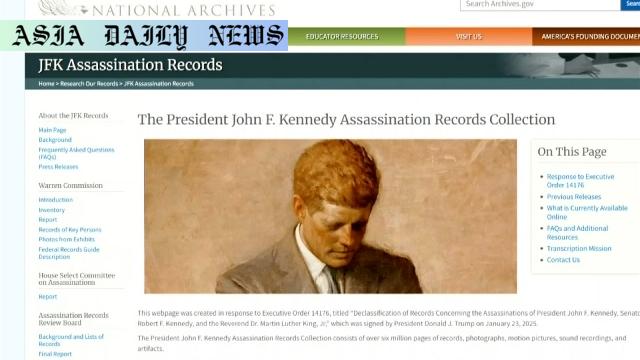JFK assassination – US authorities have disclosed 1,123 previously classified documents related to President John F. Kennedy’s assassination.
- US authorities released 1,123 JFK assassination-related documents.
- The move stems from an executive order by Donald Trump in January.
- Files include CIA testimony and details of Cold War espionage efforts.

JFK Assassination Records Unveiled: An Overview
In an unprecedented development, the United States authorities have declassified and released 1,123 documents regarding one of the most polarizing events in its history—the assassination of President John F. Kennedy. These documents are part of a broader initiative directed by former President Donald Trump in January of this year. His executive order demanded the disclosure of classified materials related to the tragic events of November 22, 1963, in Dallas, Texas. The release is considered a step towards transparency, although the sheer volume calls for extended analysis and understanding by scholars and the public alike.
Key Highlights of the Released Documents
Among the disclosed documents, attention has been drawn to testimonies provided by CIA personnel. One significant paper details counterespionage operations against the Japanese conducted by the CIA during 1941. Although it doesn’t seem directly linked to the assassination, it sheds light on the climate and workings of intelligence agencies during that period. Another document contains partial details about a Cold War-era underground tunnel in West Berlin, designed to intercept communication cables. While portions remain redacted, fragments of these insights promise to provide an enriched understanding of the geopolitical context surrounding JFK’s presidency.
Unraveling What Lies Beneath
Historians and analysts have already begun dissecting the avalanche of data. Early reviews from US media suggest that the declassified materials are unlikely to overturn the official conclusions—that Lee Harvey Oswald acted alone in the assassination. However, the significance of this release lies in its potential to fill in gaps, address inconsistencies, and perhaps demystify lingering questions. With experts estimating that it takes two full days to merely open up all these files, comprehensive understanding might still take years.
Historical Significance and Speculations
The drive to release these documents reflects ongoing public and academic interest in Kennedy’s assassination and its unresolved mysteries. Speculations over possible conspiracies, foreign involvement, and the motivations of Lee Harvey Oswald have fueled debates for decades. This latest effort may reinforce or challenge existing narratives. Additionally, the new material shines a spotlight on the capabilities and perspectives of intelligence agencies during the Cold War era.
The Road to Further Transparency
As these documents become available for review, they underline the importance of historical transparency. The lingering redactions within some documents remind us of the delicate balance between national security and public interest. Moving forward, the challenge lies in meticulously analyzing this new trove of records to deepen our comprehension of historical events and policy-making processes.



Commentary
Unveiling History: The Weight of Transparency
The release of the JFK assassination documents marks another chapter in America’s ongoing quest to confront its past and answer one of the most debated mysteries in its history. These files, brought into the public eye under Donald Trump’s executive order, are a significant step toward transparency. While it’s unlikely they will dramatically alter the official conclusion, they promise to add context to an era rife with political tensions and Cold War intrigue.
A Journey Through History
The sheer volume of more than a thousand documents underscores the magnitude of this event’s implications. The assassination of President John F. Kennedy remains a turning point in 20th-century American history. Its resonance is not just confined to the loss of a leader but also to the introspection it demanded of the nation regarding institutional trust and accountability. As new details about counterespionage and intelligence strategies unfold, they provide valuable insight into the priorities and geopolitical maneuvers of that era.
Balancing Transparency and Secrecy
Despite the excitement, one must approach these materials with a thoughtful mindset. Many sections remain redacted, inviting fresh debates about the balance between national security and the public’s right to know. There lies an opportunity here to assess the ethics and pragmatism of government transparency policies and whether they fulfill public expectations in pertinent historical inquiries. The nuances of this release raise vital questions about how democratic societies handle controversial historical narratives.
A Tribute to Ongoing Efforts
Ultimately, the release of these documents serves as a tribute to historians, analysts, and JFK researchers who have tirelessly sought answers. Their endeavors are essential to piecing together the threads of an event that continues to intrigue generations. The road ahead is marked by rigorous research and debate, as we attempt to glean lessons from the revelations and reinforce our understanding of historical integrity.